Telescope Reviews
Page 19
By Ed Ting
Updated 2/1/02
Click on a Telescope Below:
1) Starmaster 22" Dobsonian reflector
2) Meade 16" Starfinder
1) 22" Starmaster 1/1/02
(22" f/4.3 open truss Dobsonian, NLA, was $7,995)
"Aw, hell, Ed -- I'm just an ornery S.O.B. that makes telescopes, is all."
Rick Singmaster made this comment to me at the Black Forest Star Party this
year, crushing a cigarette underneath his well-worn boot. There was praise for
his telescopes coming from nearly everyone who stopped by his area, but Rick
steadfastly refused to be impressed with himself.
Starmaster telescope owners are a passionate lot. Time and time again you hear
stories of people who bought one Starmaster, then another. And another, and
another. One fan I know decorates his pickup and trailer (containing a 24") to
mimic Rick Singmaster's personal truck. Apparently some of you set up your
Starmasters in the living room, like portable furniture, instead of leaving them
out in the cold garage. And one local club member who recently took delivery
of an 11" EL slept with it in his bedroom the first night he had it (I did not ask
for details.) You could not buy loyalty like this.
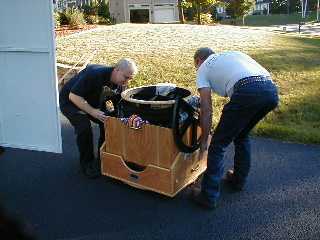 Singmaster personally delivers his larger telescopes.
Note how small the scope sits when collasped
What inspires this passion? Certainly the high quality of the products speaks
for itself, but Starmaster has always gone the extra mile with its customer
service. Ricks spends countless hours on the phone, patiently answering
questions from beginners and old hands alike. This is not an invitation to
bother them, but I've heard stories from you about Rick and/or wife Carol
answering the phone and holding long conversations after hours, without
complaint. Every Starmaster telescope larger than 20" comes with a personal
visit from Singmaster himself. For $695 Rick drives out to your house from
Kansas, delivers and sets up the scope for you, answers any questions, hangs
around while you start using it, and in general makes sure you are satisfied
with your purchase.
I recently asked Singmaster what he thinks about during those long, long drives
across the country on these delivery runs. "New telescope designs," he replied.
"Some of my best ideas have come to me while driving." Then he smiled that wry
smile. "Some of the worst ones, too. Hee Hee!" Singmaster is, of course, one
of the most colorful figures in astronomy today. With the ever-present cigarette
dangling from his mouth, he'll say whatever comes to mind, and many things do.
He has passionate convictions, and when you are talking to him, he has a way of
convincing you that what he is saying is absolutely, totally, correct.
For one thing, Rick is fanatical about observer safety. He isn't one bit shy about
designing telescopes requiring a Paracorr, if it means a shorter telescope. Ever
wonder why Starmaster telescopes are so short and squat? It's by design. Rick
is adamant about keeping the observer as close to the ground as possible. "Ed,
the last thing I need is for my customers to be fallin' off tall ladders in the middle
of the night."
Singmaster personally delivers his larger telescopes.
Note how small the scope sits when collasped
What inspires this passion? Certainly the high quality of the products speaks
for itself, but Starmaster has always gone the extra mile with its customer
service. Ricks spends countless hours on the phone, patiently answering
questions from beginners and old hands alike. This is not an invitation to
bother them, but I've heard stories from you about Rick and/or wife Carol
answering the phone and holding long conversations after hours, without
complaint. Every Starmaster telescope larger than 20" comes with a personal
visit from Singmaster himself. For $695 Rick drives out to your house from
Kansas, delivers and sets up the scope for you, answers any questions, hangs
around while you start using it, and in general makes sure you are satisfied
with your purchase.
I recently asked Singmaster what he thinks about during those long, long drives
across the country on these delivery runs. "New telescope designs," he replied.
"Some of my best ideas have come to me while driving." Then he smiled that wry
smile. "Some of the worst ones, too. Hee Hee!" Singmaster is, of course, one
of the most colorful figures in astronomy today. With the ever-present cigarette
dangling from his mouth, he'll say whatever comes to mind, and many things do.
He has passionate convictions, and when you are talking to him, he has a way of
convincing you that what he is saying is absolutely, totally, correct.
For one thing, Rick is fanatical about observer safety. He isn't one bit shy about
designing telescopes requiring a Paracorr, if it means a shorter telescope. Ever
wonder why Starmaster telescopes are so short and squat? It's by design. Rick
is adamant about keeping the observer as close to the ground as possible. "Ed,
the last thing I need is for my customers to be fallin' off tall ladders in the middle
of the night."
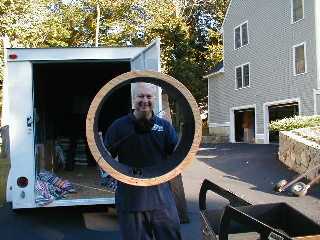 The secondary cage. Does this
new owner look happy, or what?
In a similar vein, don't ask Singmaster to mount a focuser on the left-hand side
the scope, when viewed from the rear. He won't do it. Why? A Dob tracks left
to right when viewed from the rear. With the focuser on the right, which is
conventional, you pull or track the scope towards you. Eventually you run out
of room and realize you have to move the chair or ladder. If the eyepiece were
on the left, you gradually track the scope away from you. If you're on a ladder
and not paying attention, there is a very real danger of falling.
Also, don't ask for enhanced coatings on the primary mirror, because Singmaster
won't do it. In his experience, enhanced coatings do a disservice to the ultra-
delicate and hard-won surface of a Zambuto mirror.
The 22" is no longer made, but my comments could easily apply to any of the
larger Starmaster units (the 20", 24", and the very rare 30") which are all pretty
much identical except for their apertures. The controls and styling are instantly
familiar to the Starmaster faithful. The mirror, operating at f/ 4.3, is helped by
a Paracorr at the eyepiece. The scope comes with a removable mirror cell and
a wooden case for your optics. This comes in handy for periods of rough transport,
or for long-term storage.
This sample was purchased with a Pegasus mirror, Feathertouch focuser and the
complete Sky Commander Goto system. The computer is impressive. At 98X,
the object in question is always in the field of view. Even at 220X, the object is
nearly always in the field. The upshot of this is that you can leave a relatively
high power eyepiece in the focuser without worrying whether the computer will
accurately acquire its target. Less time changing eyepieces translates into more
time spent observing.
The star test was nearly perfect, with virtually no contrast loss or coma even
at the edges of the field of view. The telescope offers a sizable gain even over
a 20", close to half a magnitude (and at this level, seeing a half magnitude deeper
than a 20" is a LOT.) The central star in the Ring was glimpsed in averted vision
even under suburban skies. Stephan's shows all its members, and with an OIII
filter the Dumbbell takes on a football shape, rather than the more familiar apple
core or hourglass shape smaller scope users know so well. The Sky Commander
is unusually accurate and bug-free, and the Goto system is very quiet. Put an
off-axis aperture mask on the scope, turn on the computer, and you'll pretty much
have the equivalent of an expensive APO for planetary/lunar/double star work.
The secondary cage. Does this
new owner look happy, or what?
In a similar vein, don't ask Singmaster to mount a focuser on the left-hand side
the scope, when viewed from the rear. He won't do it. Why? A Dob tracks left
to right when viewed from the rear. With the focuser on the right, which is
conventional, you pull or track the scope towards you. Eventually you run out
of room and realize you have to move the chair or ladder. If the eyepiece were
on the left, you gradually track the scope away from you. If you're on a ladder
and not paying attention, there is a very real danger of falling.
Also, don't ask for enhanced coatings on the primary mirror, because Singmaster
won't do it. In his experience, enhanced coatings do a disservice to the ultra-
delicate and hard-won surface of a Zambuto mirror.
The 22" is no longer made, but my comments could easily apply to any of the
larger Starmaster units (the 20", 24", and the very rare 30") which are all pretty
much identical except for their apertures. The controls and styling are instantly
familiar to the Starmaster faithful. The mirror, operating at f/ 4.3, is helped by
a Paracorr at the eyepiece. The scope comes with a removable mirror cell and
a wooden case for your optics. This comes in handy for periods of rough transport,
or for long-term storage.
This sample was purchased with a Pegasus mirror, Feathertouch focuser and the
complete Sky Commander Goto system. The computer is impressive. At 98X,
the object in question is always in the field of view. Even at 220X, the object is
nearly always in the field. The upshot of this is that you can leave a relatively
high power eyepiece in the focuser without worrying whether the computer will
accurately acquire its target. Less time changing eyepieces translates into more
time spent observing.
The star test was nearly perfect, with virtually no contrast loss or coma even
at the edges of the field of view. The telescope offers a sizable gain even over
a 20", close to half a magnitude (and at this level, seeing a half magnitude deeper
than a 20" is a LOT.) The central star in the Ring was glimpsed in averted vision
even under suburban skies. Stephan's shows all its members, and with an OIII
filter the Dumbbell takes on a football shape, rather than the more familiar apple
core or hourglass shape smaller scope users know so well. The Sky Commander
is unusually accurate and bug-free, and the Goto system is very quiet. Put an
off-axis aperture mask on the scope, turn on the computer, and you'll pretty much
have the equivalent of an expensive APO for planetary/lunar/double star work.
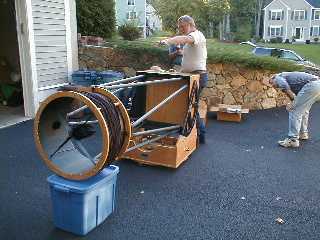 Rick gives tips on safely assembling the scope by
yourself
Singmaster's enthusiasm for astronomy and observing are infectious - we kept
finding ourselves wanting to look at just one more object before letting him
go on his way. M13 and M92 are completely resolved to the core (this is tough
on M92, which is extremely tight in its center.) The Cat's Eye is oval in shape,
has a pinpoint star in its center, and a dark halo between the star and its
nebula. Almost all globulars show color in their stars.
And if you get sick of viewing globulars in this galaxy, you can start chasing
those G globulars inside M31. G1 and G2 are readily visible, with partial
resolution in G1. The twin quasar in Ursa Major was spotted from a light-
polluted driveway. M82 and NGC4565 have detail visible in their dust lanes.
Spiral arms in M65, M66, and NGC2903 are no problem. The NGC3190 group
in Leo is no problem.
Rick gives tips on safely assembling the scope by
yourself
Singmaster's enthusiasm for astronomy and observing are infectious - we kept
finding ourselves wanting to look at just one more object before letting him
go on his way. M13 and M92 are completely resolved to the core (this is tough
on M92, which is extremely tight in its center.) The Cat's Eye is oval in shape,
has a pinpoint star in its center, and a dark halo between the star and its
nebula. Almost all globulars show color in their stars.
And if you get sick of viewing globulars in this galaxy, you can start chasing
those G globulars inside M31. G1 and G2 are readily visible, with partial
resolution in G1. The twin quasar in Ursa Major was spotted from a light-
polluted driveway. M82 and NGC4565 have detail visible in their dust lanes.
Spiral arms in M65, M66, and NGC2903 are no problem. The NGC3190 group
in Leo is no problem.
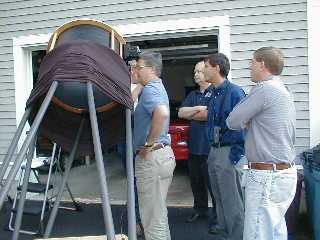 Getting a lesson on collimation
from the Master himself
Once you get into the 20" and larger range, you're in the dreadnought-class. It's
the next (and quite possibly last) jump for someone with a 14"-15" class of telescope.
With their superb quality and unmatched customer service, any of the Starmasters
carry the highest recommendation. Any of the 20" and larger units will be suitable
for someone with the money, the patience (4-8 months' delivery) and the passion to
use it. At nearly $10,000 for a scope like this 22" unit, it's the scope many of
us dream of owning. I hope you are one of the lucky few.
2) Meade 16" Starfinder Dobsonian (w/ comments on equatorial version) 1/1/02, 2/1/02
(16" f/4.5 Dobsonian reflector, 26 mm Plossl, 5X24 finder, $1195 + $45 packing +
shipping via truck freight)
This massive telescope has been in the Meade lineup in various forms since the mid 1980s.
First known as the equatorially-mounted DS16, it eventually evolved into Dobsonian form
in the 1990s. The thing is huge - the OTA weighs 100 lbs, and the rocker box weighs
another 70 lbs. It's stouter at the base than the 20" Obsession or the 22" Starmaster,
and nearly as tall. It actually weighs substantially more than the Obsession due to all
that Sonotube and particle board. On my wheeled dolly, you tend to move it very slowly -
it's impossible to get the scope to move at more than a measured, lumbering pace.
Getting a lesson on collimation
from the Master himself
Once you get into the 20" and larger range, you're in the dreadnought-class. It's
the next (and quite possibly last) jump for someone with a 14"-15" class of telescope.
With their superb quality and unmatched customer service, any of the Starmasters
carry the highest recommendation. Any of the 20" and larger units will be suitable
for someone with the money, the patience (4-8 months' delivery) and the passion to
use it. At nearly $10,000 for a scope like this 22" unit, it's the scope many of
us dream of owning. I hope you are one of the lucky few.
2) Meade 16" Starfinder Dobsonian (w/ comments on equatorial version) 1/1/02, 2/1/02
(16" f/4.5 Dobsonian reflector, 26 mm Plossl, 5X24 finder, $1195 + $45 packing +
shipping via truck freight)
This massive telescope has been in the Meade lineup in various forms since the mid 1980s.
First known as the equatorially-mounted DS16, it eventually evolved into Dobsonian form
in the 1990s. The thing is huge - the OTA weighs 100 lbs, and the rocker box weighs
another 70 lbs. It's stouter at the base than the 20" Obsession or the 22" Starmaster,
and nearly as tall. It actually weighs substantially more than the Obsession due to all
that Sonotube and particle board. On my wheeled dolly, you tend to move it very slowly -
it's impossible to get the scope to move at more than a measured, lumbering pace.
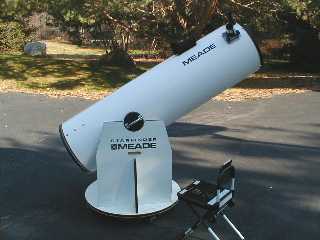 Tubby awaits darkness in my driveway
With its huge expanses of unyielding white Sonotube and melamine, this telescope has
one of the lowest SAFs (spouse approval factor) of any telescope I have ever tested.
The imposing stature of the scope was commented upon by every club member who
visited during the review period, and the scope quickly garnered nicknames: "Tubby",
"Fatso", etc. As the scope really doesn't like to move in azimuth, you have to grasp
the tube with both hands near the zenith while perched on a ladder, prompting one
member to refer to the scope as "The Widow Maker."
I had the use of this telescope for two months in the early winter of 2001. The
owner delivered the scope to me. We hauled out the pieces from his truck and
assembled it in my garage. As he left, he wished me good luck, and encouraged
me to make whatever modifications I felt were necessary. Those turned out to be
prophetic words.
Any commercial-grade Dob is a bit of a work in progress, but the Meades tend to be a
little more so. The focuser is a descendant of the infamous #77 plastic 2" focuser.
This is one product Meade should redesign, or replace altogether. I suggest the
Antares or the Orion 2" units as replacements. Others have reported success with
various JMI units. Be sure you get a focuser that puts your eyepieces about 4"
off the surface of the tube (I found this to be the approximate focal plane of the
2" TeleVue eyepieces I used.) Also, be prepared to do some modifications to the
tube. The 2" focuser I obtained from Gary Hand had a larger bore than the Meade
focuser. I spent about 3 hours with an 8 inch round body file reaming out the hole
to the proper diameter. Once done, four new holes had to be drilled for the mounting
hardware. Also, the supplied 5X24 finder has the optical quality of something you'd
find in a cereal box. Toss it and mount your own 8X50, or Telrad, or preferably both.
Tubby awaits darkness in my driveway
With its huge expanses of unyielding white Sonotube and melamine, this telescope has
one of the lowest SAFs (spouse approval factor) of any telescope I have ever tested.
The imposing stature of the scope was commented upon by every club member who
visited during the review period, and the scope quickly garnered nicknames: "Tubby",
"Fatso", etc. As the scope really doesn't like to move in azimuth, you have to grasp
the tube with both hands near the zenith while perched on a ladder, prompting one
member to refer to the scope as "The Widow Maker."
I had the use of this telescope for two months in the early winter of 2001. The
owner delivered the scope to me. We hauled out the pieces from his truck and
assembled it in my garage. As he left, he wished me good luck, and encouraged
me to make whatever modifications I felt were necessary. Those turned out to be
prophetic words.
Any commercial-grade Dob is a bit of a work in progress, but the Meades tend to be a
little more so. The focuser is a descendant of the infamous #77 plastic 2" focuser.
This is one product Meade should redesign, or replace altogether. I suggest the
Antares or the Orion 2" units as replacements. Others have reported success with
various JMI units. Be sure you get a focuser that puts your eyepieces about 4"
off the surface of the tube (I found this to be the approximate focal plane of the
2" TeleVue eyepieces I used.) Also, be prepared to do some modifications to the
tube. The 2" focuser I obtained from Gary Hand had a larger bore than the Meade
focuser. I spent about 3 hours with an 8 inch round body file reaming out the hole
to the proper diameter. Once done, four new holes had to be drilled for the mounting
hardware. Also, the supplied 5X24 finder has the optical quality of something you'd
find in a cereal box. Toss it and mount your own 8X50, or Telrad, or preferably both.
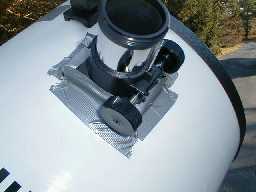 If you buy one, you'll be replacing this...
As stated earlier, the azimuth bearings are really stiff, making even moderate-power
tracking a jerky exercise in frustration. Taking the rocker box apart, I noticed that
the teflon pads ride directly against the melamine base board - no laminate to be found
here. I went to Home Depot and bought a damaged/scrap 4' X 8' sheet of Formica laminate
(total cost: $35) and nailed it to the bottom board. Now the azimuth rides somewhat
more smoothly, but there's so much weight coming down on the ground board, it's still
tough to track over 125X or so. I'd estimate the addition of the laminate only resulted
in a 10%-15% improvement in smoothness. But I'll take it - anything helps.
If you buy one, you'll be replacing this...
As stated earlier, the azimuth bearings are really stiff, making even moderate-power
tracking a jerky exercise in frustration. Taking the rocker box apart, I noticed that
the teflon pads ride directly against the melamine base board - no laminate to be found
here. I went to Home Depot and bought a damaged/scrap 4' X 8' sheet of Formica laminate
(total cost: $35) and nailed it to the bottom board. Now the azimuth rides somewhat
more smoothly, but there's so much weight coming down on the ground board, it's still
tough to track over 125X or so. I'd estimate the addition of the laminate only resulted
in a 10%-15% improvement in smoothness. But I'll take it - anything helps.
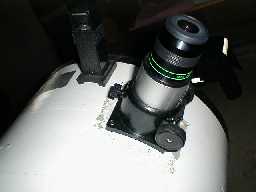 ...with one of these...
The mirror, held in place by a cell mounted on standoffs via three aluminum blocks, is
slightly undercorrected and has some minor astigmatism. Also, there is a spot of roughly
1" in diameter where the coating seems to be awfully thin. Being near the center, it didn't
seem to affect the images. There's some coma at the edges, which can be alleviated through
the use of a Paracorr. If coma bothers you, you need to add another $300 for the Paracorr
to the cost of your rig to insure your happiness. An informal poll of the club members
revealed that about half of them considered the use of the Paracorr mandatory, while the
other half felt the scope was good enough without it (although everyone present could
clearly see the improvement with the Paracorr in place.) My feelings on this? I started
off using the scope au naturel, but as time wore on, I began to appreciate what the Paracorr
did, and found it harder to use the scope without one.
...with one of these...
The mirror, held in place by a cell mounted on standoffs via three aluminum blocks, is
slightly undercorrected and has some minor astigmatism. Also, there is a spot of roughly
1" in diameter where the coating seems to be awfully thin. Being near the center, it didn't
seem to affect the images. There's some coma at the edges, which can be alleviated through
the use of a Paracorr. If coma bothers you, you need to add another $300 for the Paracorr
to the cost of your rig to insure your happiness. An informal poll of the club members
revealed that about half of them considered the use of the Paracorr mandatory, while the
other half felt the scope was good enough without it (although everyone present could
clearly see the improvement with the Paracorr in place.) My feelings on this? I started
off using the scope au naturel, but as time wore on, I began to appreciate what the Paracorr
did, and found it harder to use the scope without one.
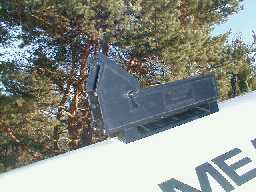 ...and adding one or more of these...
Any Sonotube-based telescope this large is bound to have some mechanical stability
issues, and this one is no exception. I noticed some tube-flexure while tracking. Stars
can be bent into all sorts of interesting shapes while you're tracking the scope. Also,
I noticed a tendency for the stars to elongate themselves into long arcs, like streaks
on an unguided astrophoto. I finally traced the problem to the secondary spider. At 3/4"
it's way too lightweight for such a large (4") secondary mirror. The vanes literally
sing when the scope is moved. I found I could pluck the vanes like strings on a guitar
and the stars would remain long arcs for twenty seconds or longer. Also, that 4"
secondary is rather aggressively oversized - the usual recommendation for a setup
like this is to use a secondary in the 3.1" to 3.3" range. Swap it out if this bothers
you.
...and adding one or more of these...
Any Sonotube-based telescope this large is bound to have some mechanical stability
issues, and this one is no exception. I noticed some tube-flexure while tracking. Stars
can be bent into all sorts of interesting shapes while you're tracking the scope. Also,
I noticed a tendency for the stars to elongate themselves into long arcs, like streaks
on an unguided astrophoto. I finally traced the problem to the secondary spider. At 3/4"
it's way too lightweight for such a large (4") secondary mirror. The vanes literally
sing when the scope is moved. I found I could pluck the vanes like strings on a guitar
and the stars would remain long arcs for twenty seconds or longer. Also, that 4"
secondary is rather aggressively oversized - the usual recommendation for a setup
like this is to use a secondary in the 3.1" to 3.3" range. Swap it out if this bothers
you.
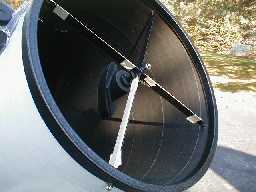 ...and damping the spider vanes like this
I finally solved this problem by taping thin strips of scrap wood to the secondary vanes.
It ain't pretty, but it works - now no matter how hard I rap the tube, the stars tend to
stay put. A more permanent solution would be to purchase a higher quality spider from
Astro Systems or Novak. All in all, you are looking at spending $300-$700 to make the
scope into a usable long-term observing instrument. Factoring this into the equation,
and adding in the shipping/trucking, you are looking at a total outlay of around $2000-
$2300, which is a lot of money but still within reason for a 16" telescope.
Finally, the altitude bearings are pitifully small at only 6". Recall that the diameter
of these bearings should be at least as large as the primary mirror (16" in this case.)
Dave Kriege of Obsession recommends that the bearings be 150% larger (or more!) if
possible. Thus, these side bearings are only 1/3 to 1/4 as large as they need to be
for smooth motions. All of the Meade Starfinders suffer to one degree or another from
this, but the 16" has it worst of all. The scope creaks every time you raise or lower
it. This "Meade Creak" is so ubiquitous that I can tell if someone has a Meade Dobsonian
in the observing field just by sitting and listening. Unfortunately, I know of no simple
solution to this one - modifying the bearing size affects many other crucial dimensions,
requiring substantial woodworking.
In reading over what I have just written, it might seem to you that I was disappointed
in this telescope. This is not the case. Once I made the necessary modifications, I
had a lot of fun with it. It gathers an impressive amount of light and gives that "big
scope" brightness that aperture-hungry observers yearn for. Most of the dim NGC
galaxies in and near Pegasus were easy prey, and I caught G1 and G2 in M31 (see above
under 22" Starmaster.) Fow low power sweeping, I threw in a 35 mm Panoptic, which
technically yields a 7.3 mm exit pupil, but I didn't care. With the 35 Pan, you can
see all of the Pleiades, 90% of the Double Cluster, and the Orion Nebula takes on some
subtle color shading. With the Paracorr in place, which acts as a 1.15X barlow, you'd
be hard-pressed to tell that you're looking through an f/4.5 optical system.
For planetary viewing, I made a cardboard off-axis aperture mask, which turned the scope
into a 6" f/12 instrument (roughly). Most large aperture Dob owners, myself included,
do not do this enough. The views of Saturn were very satisfying under good conditions,
beating out the views of everything present save for the ultra-pricey apochromatic
refractors. In fact, everyone present at the various sessions expressed surprise at
how good the stopped-down images were on Saturn. The major disappointment here
was the lack of smooth motions at high power. The mechanics bogged down when I
had to fine tune my tracking over 125X or so.
I am often asked by people if they should buy one of these. Usually, my advice is that
unless you are absolutely committed to owning a 16" telescope, buyers should scale
back their ambitions a bit and get the 12.5" Starfinder instead. You still get most
of the large aperture benefits, but the smaller scope is far more managable and less
quirky (you still have to replace the finder and focuser, though.) On the other hand, the
16" scope only costs $1195, you can take your time implementing the modifications
and upgrades, and the .65 magnitude gain over the 12.5" is nothing to sneeze at.
In short, the 16" Starfinder Dobsonian gets a modest thumbs-up, provided you know what
you are getting yourself into. Now I have to figure out a way to tell Tubby's owner
about these modifications I've made to his telescope...
Addendum: Brief Comments on the 16" Starfinder Equatorial Newtonian
Most observers are aware that Meade also sells an equatorial version of this telescope
for $2695. At a massive 247 lbs, it is just barely "portable." Although theoretically
it can be transported from one observing location to another, this is really more of a
permanent (or semi-permanent) observatory scope. It features a short, stout equatorial
mount and includes the 8X50 finder as standard. Unfortunately, Meade still supplies
the substandard plastic focuser, and the issues with the secondary vanes, coma, and tube
flexure are still prevalent. What's more, the tube is secured to the mount by Meade's
standard, less-than-reasssuring thin metal straps that seem to fly away and whack you
in the face when you least expect it. I strongly suggest the purchase of high quality
rings (like the Parallax units, about $800) if you buy this telescope. All of this
extra stuff piles on even more weight on the already-stressed mount. On the units I
have seen, this mount may be acceptable for casual use, but becomes jiggly for high
power work. Large as the equatorial mount may seem, its 1.5" shafts still aren't
large enough.
The problem here is, faults which are forgivable -even charming- on an $1195 telescope
become unacceptable on a telescope costing nearly $3000 with shipping. You should get
a good quality focuser when you spend this much, at the very least. So while the Dob-
sonian gets a mild recommendation, I have to suggest caution before laying out the bucks
on the equatorial version.
Update, 2/1/02: One reader tells me that he solved the problem of the "ringing"
secondary spider vanes by loosening the four of them, but unequally. In essence,
the idea is to de-tune the vanes by having them at four different tensions.
Another reader suggests bolstering the area of the ground board at the center
by placing home-made washers (cut from milk cartons) around the center bolt.
This is a common fix and I'm ashamed I didn't think to do it sooner. This helps.
Do it.
A third reader reports success by replacing the tiny teflon pads on the azimuth
bearing with furniture sliders. I haven't tried this, but it does make sense.
End Telescope Reviews, Page 19
...and damping the spider vanes like this
I finally solved this problem by taping thin strips of scrap wood to the secondary vanes.
It ain't pretty, but it works - now no matter how hard I rap the tube, the stars tend to
stay put. A more permanent solution would be to purchase a higher quality spider from
Astro Systems or Novak. All in all, you are looking at spending $300-$700 to make the
scope into a usable long-term observing instrument. Factoring this into the equation,
and adding in the shipping/trucking, you are looking at a total outlay of around $2000-
$2300, which is a lot of money but still within reason for a 16" telescope.
Finally, the altitude bearings are pitifully small at only 6". Recall that the diameter
of these bearings should be at least as large as the primary mirror (16" in this case.)
Dave Kriege of Obsession recommends that the bearings be 150% larger (or more!) if
possible. Thus, these side bearings are only 1/3 to 1/4 as large as they need to be
for smooth motions. All of the Meade Starfinders suffer to one degree or another from
this, but the 16" has it worst of all. The scope creaks every time you raise or lower
it. This "Meade Creak" is so ubiquitous that I can tell if someone has a Meade Dobsonian
in the observing field just by sitting and listening. Unfortunately, I know of no simple
solution to this one - modifying the bearing size affects many other crucial dimensions,
requiring substantial woodworking.
In reading over what I have just written, it might seem to you that I was disappointed
in this telescope. This is not the case. Once I made the necessary modifications, I
had a lot of fun with it. It gathers an impressive amount of light and gives that "big
scope" brightness that aperture-hungry observers yearn for. Most of the dim NGC
galaxies in and near Pegasus were easy prey, and I caught G1 and G2 in M31 (see above
under 22" Starmaster.) Fow low power sweeping, I threw in a 35 mm Panoptic, which
technically yields a 7.3 mm exit pupil, but I didn't care. With the 35 Pan, you can
see all of the Pleiades, 90% of the Double Cluster, and the Orion Nebula takes on some
subtle color shading. With the Paracorr in place, which acts as a 1.15X barlow, you'd
be hard-pressed to tell that you're looking through an f/4.5 optical system.
For planetary viewing, I made a cardboard off-axis aperture mask, which turned the scope
into a 6" f/12 instrument (roughly). Most large aperture Dob owners, myself included,
do not do this enough. The views of Saturn were very satisfying under good conditions,
beating out the views of everything present save for the ultra-pricey apochromatic
refractors. In fact, everyone present at the various sessions expressed surprise at
how good the stopped-down images were on Saturn. The major disappointment here
was the lack of smooth motions at high power. The mechanics bogged down when I
had to fine tune my tracking over 125X or so.
I am often asked by people if they should buy one of these. Usually, my advice is that
unless you are absolutely committed to owning a 16" telescope, buyers should scale
back their ambitions a bit and get the 12.5" Starfinder instead. You still get most
of the large aperture benefits, but the smaller scope is far more managable and less
quirky (you still have to replace the finder and focuser, though.) On the other hand, the
16" scope only costs $1195, you can take your time implementing the modifications
and upgrades, and the .65 magnitude gain over the 12.5" is nothing to sneeze at.
In short, the 16" Starfinder Dobsonian gets a modest thumbs-up, provided you know what
you are getting yourself into. Now I have to figure out a way to tell Tubby's owner
about these modifications I've made to his telescope...
Addendum: Brief Comments on the 16" Starfinder Equatorial Newtonian
Most observers are aware that Meade also sells an equatorial version of this telescope
for $2695. At a massive 247 lbs, it is just barely "portable." Although theoretically
it can be transported from one observing location to another, this is really more of a
permanent (or semi-permanent) observatory scope. It features a short, stout equatorial
mount and includes the 8X50 finder as standard. Unfortunately, Meade still supplies
the substandard plastic focuser, and the issues with the secondary vanes, coma, and tube
flexure are still prevalent. What's more, the tube is secured to the mount by Meade's
standard, less-than-reasssuring thin metal straps that seem to fly away and whack you
in the face when you least expect it. I strongly suggest the purchase of high quality
rings (like the Parallax units, about $800) if you buy this telescope. All of this
extra stuff piles on even more weight on the already-stressed mount. On the units I
have seen, this mount may be acceptable for casual use, but becomes jiggly for high
power work. Large as the equatorial mount may seem, its 1.5" shafts still aren't
large enough.
The problem here is, faults which are forgivable -even charming- on an $1195 telescope
become unacceptable on a telescope costing nearly $3000 with shipping. You should get
a good quality focuser when you spend this much, at the very least. So while the Dob-
sonian gets a mild recommendation, I have to suggest caution before laying out the bucks
on the equatorial version.
Update, 2/1/02: One reader tells me that he solved the problem of the "ringing"
secondary spider vanes by loosening the four of them, but unequally. In essence,
the idea is to de-tune the vanes by having them at four different tensions.
Another reader suggests bolstering the area of the ground board at the center
by placing home-made washers (cut from milk cartons) around the center bolt.
This is a common fix and I'm ashamed I didn't think to do it sooner. This helps.
Do it.
A third reader reports success by replacing the tiny teflon pads on the azimuth
bearing with furniture sliders. I haven't tried this, but it does make sense.
End Telescope Reviews, Page 19
Back to Home Page
 Singmaster personally delivers his larger telescopes.
Note how small the scope sits when collasped
Singmaster personally delivers his larger telescopes.
Note how small the scope sits when collasped The secondary cage. Does this
new owner look happy, or what?
The secondary cage. Does this
new owner look happy, or what? Rick gives tips on safely assembling the scope by
yourself
Rick gives tips on safely assembling the scope by
yourself Getting a lesson on collimation
from the Master himself
Getting a lesson on collimation
from the Master himself Tubby awaits darkness in my driveway
Tubby awaits darkness in my driveway If you buy one, you'll be replacing this...
If you buy one, you'll be replacing this... ...with one of these...
...with one of these... ...and adding one or more of these...
...and adding one or more of these... ...and damping the spider vanes like this
...and damping the spider vanes like this